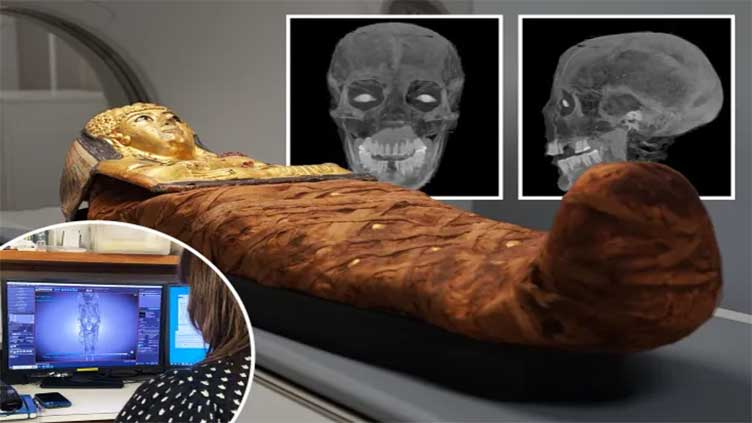3D scans show rare glimpse inside ancient Egyptian burial practices

Technology
Scientists have been able to peer inside a 3,000-year-old Egyptian "locked mummy" coffin
(Web Desk) - Scientists have been able to peer inside a 3,000-year-old Egyptian "locked mummy" coffin, without unwrapping the ancient casing.
Using 3D scans, researchers caught a rare glimpse inside ancient Egyptian burial practices, which differ greatly from the mummies that you'll see on Halloween.
Researchers at the Field Museum, Chicago, US, used a CT scanner to see inside the locked cartonnage of Lady Chenet-aa, a wealthy woman who lived during Egypt's 22nd Dynasty.
Her "locked" coffin has baffled scientists for years, as they were not sure how Chenet-aa was placed inside the casing.
The funerary box had no visible seams, just a small opening at the feet.
However, the scans put an end to that big question mark.
“You can start to see that there’s a seam going down the back and some lacing,” JP Brown, the museum’s senior conservator of anthropology, said in a statement.
Researchers now know that instead of the casing being constructed around the body, the embalmed individual was stood upright.
Using the Egyptian humidity to soften the cartonnage, embalmers then wrapped the body with it, allowing the moistness of the air to make it flexible enough to mold.
Chenet-aa also had artificial eyes made of an unknown material placed into her eye sockets to ensure they came with her into the afterlife.
Embalmers often removed the eyes, according to an earlier study, and replaced them with shells, linens, or even painted onions.
“The Ancient Egyptian view of the afterlife is similar to our ideas about retirement savings," added Brown.
"It's something you prepare for, put money aside for all the way through your life, and hope you've got enough at the end to really enjoy yourself.
“The additions are very literal. If you want eyes, then there needs to be physical eyes, or at least some physical allusion to eyes."
Chenet-aa was in her late 30s to early 40s when she died, and was missing many of her teeth.
Her remaining teeth showed signs of "significant wear", suggesting the food she ate contained stray grains of sand that were tough on the enamel.
Chenet-aa also had artificial eyes made of an unknown material placed into her eye sockets to ensure they came with her into the afterlife.
Embalmers often removed the eyes, according to an earlier study, and replaced them with shells, linens, or even painted onions.
“The Ancient Egyptian view of the afterlife is similar to our ideas about retirement savings," added Brown.
"It's something you prepare for, put money aside for all the way through your life, and hope you've got enough at the end to really enjoy yourself.
“The additions are very literal. If you want eyes, then there needs to be physical eyes, or at least some physical allusion to eyes."
Experts say the coffin is in remarkable condition taking into account its age.
Although the mystery behind Lady Chenet-aa's burial procedure has intrigued researchers for years, Chicago's Field Museum is home to over a dozen ancient Egyptian mummies.
Researchers scanned 26 mummified individuals, including granary doorkeeper Harwa, through the mobile CT scanner, which was parked outside of the museum.
“From an archaeological perspective, it is incredibly rare that you get to investigate or view history from the perspective of a single individual,” said Stacy Drake, Human Remains Collection Manager at the Field Museum.



